Abstract
Every year 150 million new cases of sexually transmitted infection are expected to occur around the world with high occurrence and morbidity rates in both males and females. To respond to dramatically changing social and cultural environments, clinical treatment guidelines for diagnosis, treatment, and prevention of sexually transmitted infections have been developed in many countries, and South Korea has also prepared treatment guidelines which can be used in medical institutions treating primarily these diseases. Against this background, this study conducted a 31-item questionnaire survey by mail and e-mail to investigate the actual clinical practices of physicians treating sexually transmitted infections. In total, 250 and 1,068 questionnaires were distributed through mail and e-mail, respectively, and 274 of them were completed and returned for a response rate of 20.8%. According to the results, physicians' actual clinical practices were found to be different from textbook guidelines to some degree. Therefore, treatment guidelines that take into account the current situation for sexually transmitted infections should be developed in Korea, and a foundation for national management of the diseases should be established through active advertisements.
Figures and Tables
References
1. Guidelines for management of sexually transmitted infection [Internet]. 2008. cited 2009 June 15. Seoul: Korean Center for Disease Control and Prevention;Available from:
http://www.cdc.go.kr/kcdchome/FileDownload.do?file=/board/582/2008081917574734_20904_0.hwp.
2. Workowski KA, Berman SM. Centers for Disease Control and Prevention. Sexually transmitted diseases treatment guidelines, 2006. MMWR Recomm Rep. 2006. 55:1–94.

4. Lukehart SA. Serologic testing after therapy for syphilis: is there a test for cure? Ann Intern Med. 1991. 114:1057–1058.

5. Elliott WC. Treatment of primary syphilis. J Am Vener Dis Assoc. 1976. 3(2 Pt 2):128–135.
6. Idsoe O, Guthe T, Willcox RR. Penicillin in the treatment of syphilis: the experience of three decades. Bull World Health Organ. 1972. 47:Suppl. 1–68.
7. Rolfs RT, Joesoef MR, Hendershot EF, Rompalo AM, Augenbraun MH, Chiu M, Bolan G, Johnson SC, French P, Steen E, Radolf JD, Larsen S. The Syphilis and HIV Study Group. A randomized trial of enhanced therapy for early syphilis in patients with and without human immunodeficiency virus infection. N Engl J Med. 1997. 337:307–314.

8. Gaydos CA, Quinn TC. Urine nucleic acid amplification tests for the diagnosis of sexually transmitted infections in clinical practice. Curr Opin Infect Dis. 2005. 18:55–66.

9. Bloomfield PJ, Steiner KC, Kent CK, Klausner JD. Repeat chlamydia screening by mail, San Francisco. Sex Transm Infect. 2003. 79:28–30.

10. Johnson RE, Newhall WJ, Papp JR, Knapp JS, Black CM, Gift TL, Steece R, Markowitz LE, Devine OJ, Walsh CM, Wang S, Gunter DC, Irwin KL, DeLisle S, Berman SM. Screening tests to detect Chlamydia trachomatis and Neisseria gonorrhoeae infections--2002. MMWR Recomm Rep. 2002. 51:1–38.
11. Tapsall JW, Limnios EA, Abu Bakar HM, Darussalam B, Ping YY, Buadromo EM, Kumar P, Singh S, Lo J, Bala M, Risbud A, Deguchi T, Tanaka M, Watanabe Y, Lee K, Chong Y, Noikaseumsy S, Phouthavane T, Sam IC, Tundev O, Lwin KM, Eh PH, Goarant C, Goursaud R, Bathgate T, Brokenshire M, Latorre L, Velemu E, Carlos C, Leano S, Telan EO, Goh SS, Koh ST, Ngan C, Tan AL, Mananwatte S, Piyanoot N, Lokpichat S, Sirivongranson P, Fakahau M, Sitanilei H, Hung le V. Surveillance of antibiotic resistance in Neisseria gonorrhoeae in the WHO Western Pacific and South East Asian regions 2007-2008. Commun Dis Intell. 2010. 34:1–7.
12. Yong D, Kim TS, Choi JR, Yum JH, Lee K, Chong Y, Oh HB, Shultz T, Tapsall JW. Epidemiological characteristics and molecular basis of fluoroquinolone-resistant Neisseria gonorrhoeae strains isolated in Korea and nearby countries. J Antimicrob Chemother. 2004. 54:451–455.

13. Yoo J, Yoo C, Cho Y, Park H, Oh HB, Seong WK. Antimicrobial resistance patterns (1999-2002) and characterization of ciprofloxacin-resistant Neisseria gonorrhoeae in Korea. Sex Transm Dis. 2004. 31:305–310.

14. Bodsworth NJ, Crooks RJ, Borelli S, Vejlsgaard G, Paavonen J, Worm AM, Uexkull N, Esmann J, Strand A, Ingamells AJ, Gibb A. International Valaciclovir HSV Study Group. Valaciclovir versus aciclovir in patient initiated treatment of recurrent genital herpes: a randomised, double blind clinical trial. Genitourin Med. 1997. 73:110–116.

15. Chosidow O, Drouault Y, Leconte-Veyriac F, Aymard M, Ortonne JP, Pouget F, Revuz J, Decazes JM, Malkin JE. Famciclovir vs. aciclovir in immunocompetent patients with recurrent genital herpes infections: a parallel-groups, randomized, double-blind clinical trial. Br J Dermatol. 2001. 144:818–824.

16. Fife KH, Barbarash RA, Rudolph T, Degregorio B, Roth R. The Valaciclovir International Herpes Simplex Virus Study Group. Valaciclovir versus acyclovir in the treatment of first-episode genital herpes infection. Results of an international, multicenter, double-blind, randomized clinical trial. Sex Transm Dis. 1997. 24:481–486.

17. Diaz-Mitoma F, Sibbald RG, Shafran SD, Boon R, Saltzman RL. Collaborative Famciclovir Genital Herpes Research Group. Oral famciclovir for the suppression of recurrent genital herpes: a randomized controlled trial. JAMA. 1998. 280:887–892.

18. Gross G, Ikenberg H, Gissmann L, Hagedorn M. Papillomavirus infection of the anogenital region: correlation between histology, clinical picture, and virus type. Proposal of a new nomenclature. J Invest Dermatol. 1985. 85:147–152.

19. Franco EL, Duarte-Franco E, Ferenczy A. Cervical cancer: epidemiology, prevention and the role of human papillomavirus infection. CMAJ. 2001. 164:1017–1025.
20. Koutsky LA, Galloway DA, Holmes KK. Epidemiology of genital human papillomavirus infection. Epidemiol Rev. 1988. 10:122–163.

21. Chuang TY, Perry HO, Kurland LT, Ilstrup DM. Condyloma acuminatum in Rochester, Minn., 1950-1978. I. Epidemiology and clinical features. Arch Dermatol. 1984. 120:469–475.

22. Silverberg MJ, Ahdieh L, Munoz A, Anastos K, Burk RD, Cu-Uvin S, Duerr A, Greenblatt RM, Klein RS, Massad S, Minkoff H, Muderspach L, Palefsky J, Piessens E, Schuman P, Watts H, Shah KV. The impact of HIV infection and immunodeficiency on human papillomavirus type 6 or 11 infection and on genital warts. Sex Transm Dis. 2002. 29:427–435.

23. Simmons PD, Langlet F, Thin RN. Cryotherapy versus electrocautery in the treatment of genital warts. Br J Vener Dis. 1981. 57:273–274.

24. Abdullah AN, Walzman M, Wade A. Treatment of external genital warts comparing cryotherapy (liquid nitrogen) and trichloroacetic acid. Sex Transm Dis. 1993. 20:344–345.





 PDF
PDF ePub
ePub Citation
Citation Print
Print


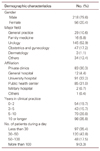

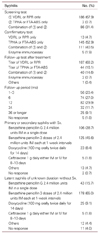
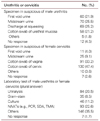
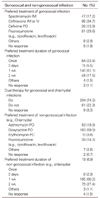
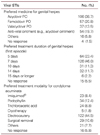

 XML Download
XML Download